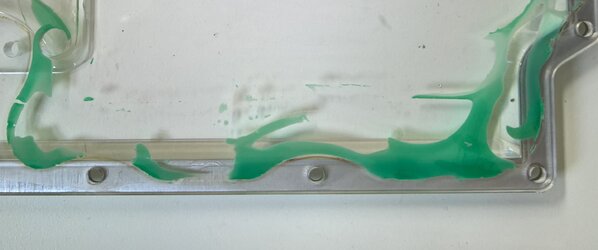So I'm replacing my power supply in my computer. I figured I would go ahead and clean my water cooling system while I have it open. And throughout the system there is a green flat crust. Not something that I would classify is algae, I could be wrong though. It's flakes off but require some effort to scrape it off. I wanna clean off the plexiglass on my video card blocks. Can someone recommend the best way to get this off without having to scrape it? I don't want to damage the plexiglass.
-
Welcome to Overclockers Forums! Join us to reply in threads, receive reduced ads, and to customize your site experience!
You are using an out of date browser. It may not display this or other websites correctly.
You should upgrade or use an alternative browser.
You should upgrade or use an alternative browser.
Green crust in system
- Thread starter Thick8
- Start date
- Joined
- May 22, 2011
- Location
- USA
Give us a bit more info. What liquids was used in this rig? I'm guessing green dye here.
- Joined
- Oct 11, 2002
- Location
- The Empire State
I'm thinking it's dried green dye pigment from the liquid that was being used.
- Thread Starter
- #5
No dyes at all. When I built the system I flushed the copper heat exchanger with with white vinegar then with distilled water. Filled the system with pure distilled water and put silver coils in the reservoir. The fittings are all silver plated compression fittings that are not flaking at all. No additive, no dyes, no nuthin'.
The copper blocks also have a copious amount of this coating as well.
I sprayed one of the plexi covers with straight bleach and let it sit for about an hour. Didn't even take the color out of it and its still rock hard. I'm wondering if it might be copper oxidization. That would suck as my heat exchanger is 35 feet in the ground; and oxidation is a thermal insulator, not a thermal conductor.
When I took apart my CPU block there were pieces of this "material" caught up in the pins. They looked to have broken off of somewhere else in the system and lodged there as apposed to forming in place.
It reminds me of copper that's been exposed to chlorine but the system never had any chlorine near it.
If I didn't get all of the vinegar out of the system would it cause green scaling?
I found this.
There may instead be precipitation of bicarbonate and sodium byproducts out of the water in such a way as to loosely adhere to the tube wall and react with the copper surface to form a blue/green copper carbonate. This material is very friable and can easily flake off into the water stream when the plumbing system is put into service. It seems to occur most often when water high in bicarbonates has been allowed to stand in the piping system for some time, especially when exposed to high ambient temperatures. For instance, if a house is built and left standing while waiting for completion or occupancy during the heat of the summer months.
While I used pure distilled water, this seems to be what I have going on.
maybe the flux I used when soldering the joints of the heat exchanger.
So I've done some reading. It would seem that copper pipe actually forms a good coating inside the pipe. Now if the system sits for extended periods (like my computer)and is subject to high ambient temperature (82F when running hard), the pipe will not form this coating. Also if the water is exposed to air it will draw in suck in CO2 from the air (I have at times had my digital thermometer in the open plug of the reservoir). What happens is that the normal PH (7.0) of the distilled water will drop significantly. This causes cuprosolvency.The water may also take on a blue tinge. I tested my water with a pool test strip and it didn't register on the lowest value of 6.2.
I used a vacuum extractor to empty the system. when I poured some water from it into a glass to check the PH it looked like this.

It didn't look like this in the system. And it looks a little darker in the picture than in person but it would seem that I've found my issue. Now I just have to figure out how to eliminated it. PEX tube as the heat exchanger? Will an automotive coolant eliminate the problem? I don't know at this point but it's pretty obvious that I will have to pull the exchanger out of its hole.
The copper blocks also have a copious amount of this coating as well.
I sprayed one of the plexi covers with straight bleach and let it sit for about an hour. Didn't even take the color out of it and its still rock hard. I'm wondering if it might be copper oxidization. That would suck as my heat exchanger is 35 feet in the ground; and oxidation is a thermal insulator, not a thermal conductor.
When I took apart my CPU block there were pieces of this "material" caught up in the pins. They looked to have broken off of somewhere else in the system and lodged there as apposed to forming in place.
It reminds me of copper that's been exposed to chlorine but the system never had any chlorine near it.
If I didn't get all of the vinegar out of the system would it cause green scaling?
I found this.
There may instead be precipitation of bicarbonate and sodium byproducts out of the water in such a way as to loosely adhere to the tube wall and react with the copper surface to form a blue/green copper carbonate. This material is very friable and can easily flake off into the water stream when the plumbing system is put into service. It seems to occur most often when water high in bicarbonates has been allowed to stand in the piping system for some time, especially when exposed to high ambient temperatures. For instance, if a house is built and left standing while waiting for completion or occupancy during the heat of the summer months.
While I used pure distilled water, this seems to be what I have going on.
maybe the flux I used when soldering the joints of the heat exchanger.
So I've done some reading. It would seem that copper pipe actually forms a good coating inside the pipe. Now if the system sits for extended periods (like my computer)and is subject to high ambient temperature (82F when running hard), the pipe will not form this coating. Also if the water is exposed to air it will draw in suck in CO2 from the air (I have at times had my digital thermometer in the open plug of the reservoir). What happens is that the normal PH (7.0) of the distilled water will drop significantly. This causes cuprosolvency.The water may also take on a blue tinge. I tested my water with a pool test strip and it didn't register on the lowest value of 6.2.
I used a vacuum extractor to empty the system. when I poured some water from it into a glass to check the PH it looked like this.
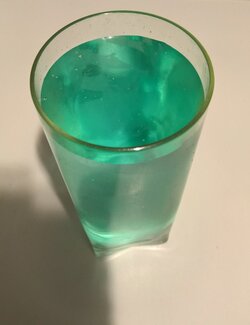
It didn't look like this in the system. And it looks a little darker in the picture than in person but it would seem that I've found my issue. Now I just have to figure out how to eliminated it. PEX tube as the heat exchanger? Will an automotive coolant eliminate the problem? I don't know at this point but it's pretty obvious that I will have to pull the exchanger out of its hole.
Last edited by a moderator:
- Joined
- Jan 10, 2012
I use distilled water, read the label, distilled, and 25% zerex, z05, known as hoat with no issues at all.
- Thread Starter
- #7
Before I started this journey of discovery I put my GPU copper block into a bath of white distilled vinegar. It's now mostly clean. All the green scaling is gone but the brown "rust" is still present. I'll leave it in there for a little while to see what happens. I may be able to just clean the heat exchanger while it's still in the ground, Yea! Now to figure out what to fill it back up with. Maybe distilled water and baking soda to maintain the PH.
- Thread Starter
- #9
Lochekey, This is the first time I've changed it. So it's been a week or two less than a full year.
Caddi Daddi, 25/75 Zerex/distilled? any noticeable depreciation in water flow or lower thermal properties? Is it dye free? Do you mean G05? Because I can't find Z05.
Caddi Daddi, 25/75 Zerex/distilled? any noticeable depreciation in water flow or lower thermal properties? Is it dye free? Do you mean G05? Because I can't find Z05.
Last edited:
- Joined
- Jan 10, 2012
I am told it's gold, I'm color blind, but at 25% it's clear, I have noticed no issues with reduced flow and a big perk is that I can drag the rigs out in the garage in the winter for really big clocks without having to worry about a freeze issue, if you're up north, you might have a freeze at 25%
there is one plus I have found with it, with the ceramic bearing pumps they seem to stay quiet longer, it may lube the bearing surface better than just water, I dunno.
there is one plus I have found with it, with the ceramic bearing pumps they seem to stay quiet longer, it may lube the bearing surface better than just water, I dunno.
- Thread Starter
- #11
I am told it's gold, I'm color blind, but at 25% it's clear, I have noticed no issues with reduced flow and a big perk is that I can drag the rigs out in the garage in the winter for really big clocks without having to worry about a freeze issue, if you're up north, you might have a freeze at 25%
there is one plus I have found with it, with the ceramic bearing pumps they seem to stay quiet longer, it may lube the bearing surface better than just water, I dunno.
I noticed that the automotive manufacturers have switched from hoat to oat coolants that no longer contain the silicates that the hoat coolants have. I'm wondering if this might be better for heat transfer. I'll let you know what I find out.
I also found this link that make me wonder if I didn't get all the vinegar out of the system. http://jewelrymakingjournal.com/vinegar-and-salt-patina/
- Joined
- May 8, 2011
- Location
- Darlington, South Carolina
I noticed that the automotive manufacturers have switched from hoat to oat coolants that no longer contain the silicates that the hoat coolants have. I'm wondering if this might be better for heat transfer. I'll let you know what I find out.
I also found this link that make me wonder if I didn't get all the vinegar out of the system. http://jewelrymakingjournal.com/vinegar-and-salt-patina/
Any automotive glycol based coolants you add are going to lessen the coolant effectiveness.
Question: Are the Silver Kill coils still silver?
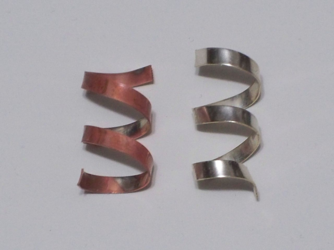
The coil on the right never used, the coil on the left almost looked like it was being copper plated and it is actually bonded to the silver it doesn't rub off, and there is no electrical current going through the coolant to support plating, so my end thoughts were some kind of chemical reaction going on?
It also copper colored the chromed Bitspower return jet tube in the reservoir but I don't have a picture of that, I am just assuming that Bitspower jet tube is chrome it could be nickel plated?
Traces of the vinegar, (an acid base), could have reacted with the silver/copper I had a similar experience myself and the coolant was turning color as well once I saw what was happening with the coil I drained the loop and tore it down cleaned and flushed it, and since then I have never used another silver coil and will not use one, I simply use "PT-Nuke" biocide (Copper Sulfate) and no more problems.
Last edited:
- Thread Starter
- #13
I flushed the heat exchanger with vinegar for about 6 hours. Then I flushed it 3 times with 5 gallons of distilled water. I had my wife smell it to see if there was any vinegar left in it. She even tasted it and verified that it was clean. Then I filled it with a 25% OAT coolant mix. I even put a fuel filter in line to catch any debris during the flush procedure. I just finished re-assembling all my blocks and coolers but I'll be out of town for a week so I won't have any running numbers till I get back and finish assembling the computer. I'm hoping there won't be too great a temp difference. I did use Thermal Grizzly Kryonaut this time. It's supposed to have a much better heat transfer than the old AS5 I used the last time. So maybe I'll end up at the same place temperature wise.
Any automotive glycol based coolants you add are going to lessen the coolant effectiveness.
This issue is always is over emphasised within PC watercooling forums when in reality glycol is not that much worse than water when used in the appropriate mix ratios one would typically use in our PC loops.
Source: http://www.engineeringtoolbox.com/ethylene-glycol-d_146.html
Typical for our needs, 5% to 10% glycol content is all that we need to keep corrosion well at bay.
Even if you upped the glycol content to a silly 25% you would still achieve over 92% the effectiveness of water as far as heat transfer is concerned. At 5% content you would be well above 95% equivalence so in practice its a non event.
Automotive coolants when diluted appropriately cannot really be beat as far as corrosion protection is concerned as they work by clinging and coating the surface of the metals (old style non OAT coolants are recommended over the newer acid types). This is why when using an auto coolant your blocks will never readily oxidise and they will tend to maintain their shiny new polished look.
You could seal up a system for over 2 Years without any maintenance and your blocks will still look shiny and new on the inside when the coolant is drained.
- Joined
- Jan 10, 2009
This issue is always is over emphasised within PC watercooling forums when in reality glycol is not that much worse than water when used in the appropriate mix ratios one would typically use in our PC loops.
Source: http://www.engineeringtoolbox.com/ethylene-glycol-d_146.html
Typical for our needs, 5% to 10% glycol content is all that we need to keep corrosion well at bay.
Even if you upped the glycol content to a silly 25% you would still achieve over 92% the effectiveness of water as far as heat transfer is concerned. At 5% content you would be well above 95% equivalence so in practice its a non event.
Automotive coolants when diluted appropriately cannot really be beat as far as corrosion protection is concerned as they work by clinging and coating the surface of the metals (old style non OAT coolants are recommended over the newer acid types). This is why when using an auto coolant your blocks will never readily oxidise and they will tend to maintain their shiny new polished look.
You could seal up a system for over 2 Years without any maintenance and your blocks will still look shiny and new on the inside when the coolant is drained.
I agree with the above statement: "You could seal up a system for over 2 Years without any maintenance and your blocks will still look shiny and new on the inside when the coolant is drained" as a matter of fact i used a sealed system for 3.5 years with Koolance blocks for the cpu and gpu used Koolance fittings and a Alphacool 360 Monsta rad. This system was my secondary and not my main rig which i maintain every 12 to 14 months even when i open my main rig blocks they are clean.
This is my secondary loop and i was shocked how utterly clean it looked after 3.5 years!! without ever opening it it looked like NEW. As coolant i used Koolance clear premix coolant i did changed the coolant after approx 2 years as stated by the manufacturer.
Nothing to see no oxidation no rust no crap inside the cpu fins just a clean block:
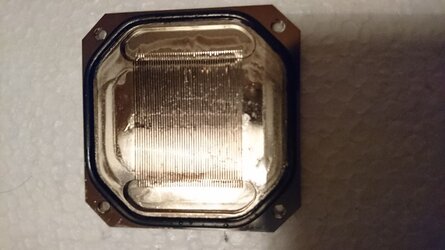
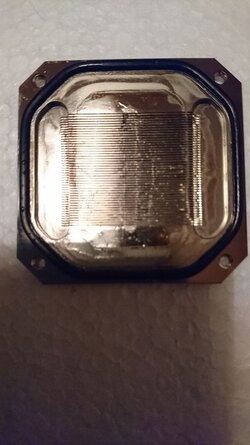
All my fittings that i used mostly black koolance fittings where spotless clean as if they where new. I also used 2 Bitspower black compressions they to where spotless clean!
On a side note i used a Heatkiller 3.0 full nickel plated with plain distilled and 2 silver kill coils and the result after one year wasnt that impressive as the above block, this time around i could see a change in color, spots of greenish oxidation if i could post it here i would but they are more then 2.75mb. This was back in 2009/2010 when people screamed distilled + silver kill coil is all you need until more and more people had issues with their nickel blocks and even copper.
So from now on why the risk i now only use the recommended Coolant as what the manufacturer tells its costumers. And it works from my own experience Koolance pre mix coolant is really good i also heard great things with Innovatek Protect concentrate or pre mix coolant for use with Watercool blocks like the heatkiller IV Watercool strongly advise to use Innovatek protect coolant infact the representative from watercool uses Innovatek protect for 2 years and his blocks looks like new. They all are against distilled water and silver kill coil...and i can confirm it will mess up your nickel plated blocks, this is from my own experience. Some would say Snake oil charging a premium for pre mix coolant but they work like a charm (atleast the Koolance clear pre mix that i used) i used cheap distilled + silver and it almost ruined my block had i not opened it up after one year. I don't mind spending that extra on coolant. Another vote goes to "basf Glysantin G48" car coolant popular within the German water cooling forums and they swear on it a mixture of 1 part G48 with 9 part distilled is what they use.
Personally one should use anti oxidation with their coolant even when its full copper blocks. But i believe when you use full copper blocks and full copper rads then distilled plus silver kill coil or pt-nuke is good enough from the feed back i saw. If one changes coolant (distilled + silver or pt-nuke) every 6 months. Thats because it has no anti oxidation properties to bypass that is to change the coolant after 6 months tell me if i am wrong...
Last edited:
- Joined
- May 22, 2011
- Location
- USA
I've been mainly copper with distilled and kill coils. I do run into oxidization but usually run them through some vinegar and distilled mix to clean them up a bit but never get them looking new again.
I will say I've been a bit taken back by the complaints as of lately with the same combination of folks using nickel plated gear. Even those manufacturers warn not to use it but over the years many never complained so I feel I'm at a standstill. I will eventually do a complete breakdown towards the end of the year and check my CPU block. If it looks nasty as my other CPU blocks from the past, I might be making the switch as well because I get tired of oxidization but my silver bistpower fittings look good as new, except when I once was using a bunch of Koolance QDCs.
I will say I've been a bit taken back by the complaints as of lately with the same combination of folks using nickel plated gear. Even those manufacturers warn not to use it but over the years many never complained so I feel I'm at a standstill. I will eventually do a complete breakdown towards the end of the year and check my CPU block. If it looks nasty as my other CPU blocks from the past, I might be making the switch as well because I get tired of oxidization but my silver bistpower fittings look good as new, except when I once was using a bunch of Koolance QDCs.
- Joined
- Jan 10, 2009
I've been mainly copper with distilled and kill coils. I do run into oxidization but usually run them through some vinegar and distilled mix to clean them up a bit but never get them looking new again.
I will say I've been a bit taken back by the complaints as of lately with the same combination of folks using nickel plated gear. Even those manufacturers warn not to use it but over the years many never complained so I feel I'm at a standstill. I will eventually do a complete breakdown towards the end of the year and check my CPU block. If it looks nasty as my other CPU blocks from the past, I might be making the switch as well because I get tired of oxidization but my silver bistpower fittings look good as new, except when I once was using a bunch of Koolance QDCs.
Hello,
Making the switch to? To nickel plated? Ive read that some people who used all copper blocks and rad insist in using an anti oxidation with their distilled water previously they used only distilled + silver kill coil but the oxidation process would start sooner then they expected. Thats why they changed to coolant or rather pre mix coolant like Mayhem XT-1 and the result was much longer shiny copper blocks. Also read allot of good stuff about Innovatek protect concentrate or pre mix with only full copper loop or mixed. Added bonus is as you already know protection against algae due to glycol. I see a difference between the American water cooling scene and European water cooling scene in Europe more people use pre mix coolant of good quality that lasts long or car based coolant. While in the US more people use distilled + pt-nuke or silver kill coils. PT-nuke is hard to get in Europe. In any case ive experienced both ends and the pics tell all there is to know in my case. Spend the extra on good pre mix and be done with it.
- Thread Starter
- #18
I'm pretty sure that the source of my issue was in fact a manufacturing issue on 1 of my GPU coolers. The cooler was in the #1 PCIe slot so I was unable to see the problem because that card was blocked from view by the card in the #3 slot. There are water channels machined into both sides of the plexi. The channel that feeds the the VRMs and the bottom half of the block was not machined completely through. So where the water pass-through hole was supposed to be there was a fingernail thin piece of plexi blocking it. This starved the bottom half of the block of water and created a (rather large) air pocket. I believe that this is where the corrosion began and then traveled throughout the system. Because everything else cleaned up nicely but that area, and it's heavily corroded. Maybe I can RMA it.
- Joined
- May 8, 2011
- Location
- Darlington, South Carolina
I'm pretty sure that the source of my issue was in fact a manufacturing issue on 1 of my GPU coolers. The cooler was in the #1 PCIe slot so I was unable to see the problem because that card was blocked from view by the card in the #3 slot. There are water channels machined into both sides of the plexi. The channel that feeds the the VRMs and the bottom half of the block was not machined completely through. So where the water pass-through hole was supposed to be there was a fingernail thin piece of plexi blocking it. This starved the bottom half of the block of water and created a (rather large) air pocket. I believe that this is where the corrosion began and then traveled throughout the system. Because everything else cleaned up nicely but that area, and it's heavily corroded. Maybe I can RMA it.
It was probably caused by the flux from the soldering process and the chemical reaction of the coolant with traces of vinegar in the line as vinegar is an acid base, and the copper solder flux is also an acid base.
I think someone mentioned a baking soda flush that may be a good idea just make sure it is completely dissolved in water and that will neutralize any acid still in the tubing.
Similar threads
- Replies
- 3
- Views
- 189
- Replies
- 6
- Views
- 781
